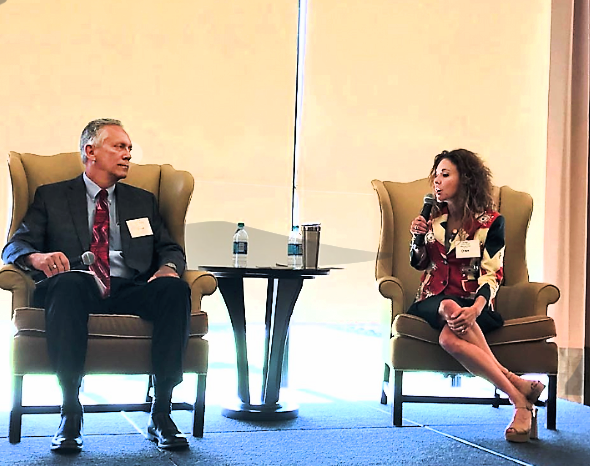
By Callan Smith | Rose Law Group Reporter
Labor shortages affecting the construction industry from homebuilding to industrial projects was the topic of discussion Thursday morning to a crowd at Valley Partnership in Phoenix.
Panelists included Dan Haag, Sundt Construction senior vice president and chief administration officer; Jackie Elliott, Ed. D., Central Arizona College president and CEO, Central Arizona College, and Mike Greenawalt, Rosendin Electric, senior vice president of operations. Jordan Rose, Rose Law Group founder and president, moderated.
How did we get here, Rose asked about the lack of enough construction workers.
It happened over a 30-year span with the economy crash, which brought it on rapidly, Greenawalt said.
“I never would have imagined we’d be in this position,” Rose said
Greenawalt recalled his experience in 1979 going for an apprenticeship with 200 people vying for 30 spots.
“We were having a difficult time in the early 2000’s getting apprentices coming to programs,” he said. “Industry associations and numbers were telling us that the workers were aging out.”
“Do you think it’s because the youth don’t have an interest [in construction trades],” Rose asked?
“They don’t, Greenawalt answered. “The industrial arts programs have been cut from the elementary schools–we’ve done it to ourselves.”
“Melvin,” the character used by Parker & Sons in Phoenix TV ads was referenced as negative image.
“Melvin is screwing up our industry because today people still perceive construction workers as a Melvin,” Greenwalt said. “When I would sit at my son’s high school functions and tell people I’m an electrician, they look at me like you’re an electrician? Construction trades have been absent from our education system since the early eighties.”
Community colleges were formed as part of the GI Bill for returning servicemen to learn a skill, a craft or trade. “Over the years, we’ve lost sight of that and allowed ourselves to become little universities,” Elliott said.
“Can I get on my soapbox now? As a thirty-year educator, higher education has failed the trades, Elliott said. “We have failed the craft workforce.”
“We have to make the trades acceptable to the parents and the public,” she said.
“We need to start educating about the trade skills in the seventh grade,” Greenawalt added.
Haag: “I would agree it’s a combination with the aging workforce. We lost a lot of craft in the downturn; they moved somewhere else, started doing something else. The decline of the CTE (Career & Technical Education) programs, we did that to ourselves,”
CTE programs or Postsecondary CTE, such as Western Maricopa Education Centers, West-Mac, East Valley Institute of Technology, EVIT, and Central Arizona Valley Institute of Technology, CAVIT, teach skilled trades at campuses throughout Arizona.
“If you look at the job training education areas, they’re growing because students have interest,” Elliott said. “This generation wants hands-on technology-infused learning opportunities that are project-based, such as EVIT, CAVIT, West-Mac, K-12 and higher ed need to wake up and pay attention,”
EVIT and West-Mac programs are phenomenal and growing, Greenawalt said.
“At Sundt, forty percent of leadership has come from the crafts, the trades,” Haag said, noting Mike Hoover, Sundt’s CEO started in the trades.
Recently Haag attended a graduation of students from Central Arizona College (CAC) that Sundt partners with a certificate and academic apprenticeship programs in heavy equipment operator, structural welding, pipefitting, industrial construction and concrete construction technology.
Haag said he asked students why they went into the trades receiving answers, such as wanting to work outdoors, using one’s natural talents, the desire to travel, learn and grow, experience construction and to be a better man.
“We need to do a better job in the school systems. We need to encourage CTE programs and encourage counselors” Haag said.
“Nobody said anything about immigration, Rose said. “Didn’t that hurt us? Wasn’t that the issue at one point?”
A lot of residential contractors rely on Hispanic workers, Greenawalt said. “Our main feeder for the last twenty years has been Hispanic workers [but] they’re not comfortable to be here.”
If you were the president or governor what would you do, Rose asked the panel.
“I would put more money into education, the trade programs, the Trade Adjustment Act. I would put money into getting those trade programs back into schools and colleges,” Elliott said. Word choice is important, changing from a votech reference to professional titles such as craft professional, which Sundt uses, she said.
Haag echoed Elliott’s statement that educational programs are needed within K-12 and community colleges, creating more a presence there.
Sundt’s partnership with CAC is about helping the industry. They are fighting to hire graduates with other companies.
“What’s interesting for me–my mindset has shifted– for so long in higher education it was a shotgun scatter approach [meaning] come here take these classes students, good luck, hope you graduate and go to work somewhere. Now they’re starting with the end in mind,” Elliott said.











